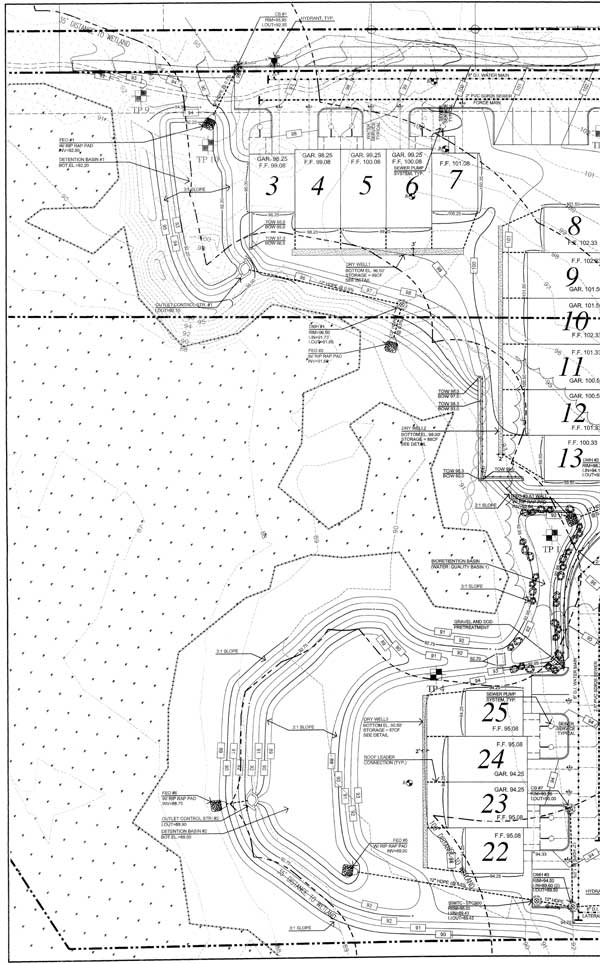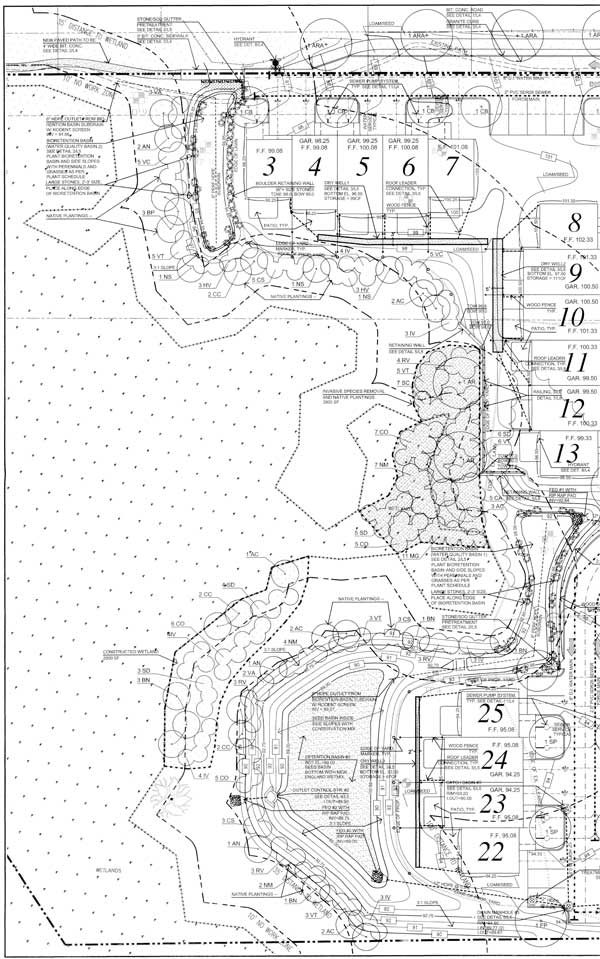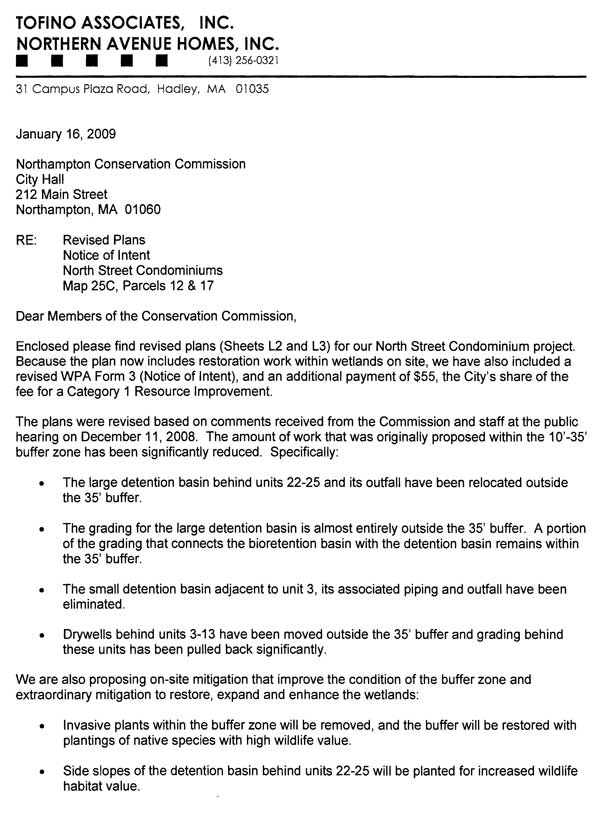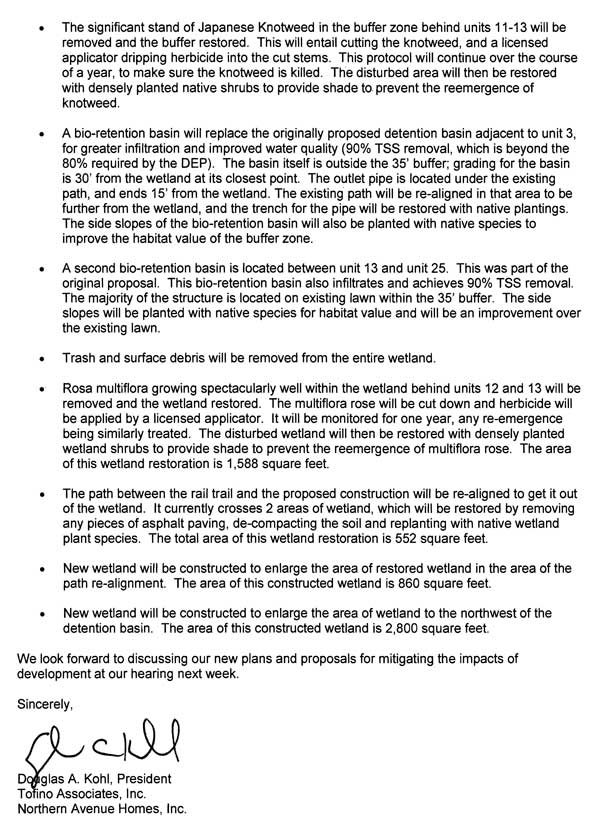Kohl Construction, doing business as Tofino Associates/Northern Avenue Homes, submitted a revised condo proposal to the Conservation Commission on Friday. Download PDFs of the revised proposal (1.96MB) and associated narrative (1.31MB). This proposal will come before the Conservation Commission and the Planning Board on January 22 (see below). Concerned citizens are urged to attend.
Here is a detail of Kohl’s original proposal as reviewed by the Conservation Commission on December 11:

Here is the same area in Kohl’s revised proposal:

Here are our initial impressions of the revised proposal:
- Kohl has made only modest concessions to the Conservation Commission’s objections. His proposal still calls for a good deal of disturbance inside of the 35-foot wetland buffer line.
- Kohl’s proposal appears to call for the kind of big “holes in the ground” (detention and bioretention basins), which Land Use and Conservation Planner Bruce Young disfavors.
- Kohl’s proposal now calls for constructing new wetlands. This has had mixed results elsewhere.
- Kohl has not yet recalculated stormwater flows for his revised
proposal, so we can’t evaluate if the revised proposal handles
stormwater as well as the original one.
Here is the narrative Kohl included with the revised proposal:


Here are the January 22 public hearings that will consider Kohl’s revised proposal. Please come!
CONSERVATION COMMISSION MEETING
Date: Thursday January 22, 2009
Time: 5:30 PM
Place: City Hall Hearing Room (use back door or main Crafts Avenue door) 2nd floor, 210 Main Street, NorthamptonFor more information: Bruce W. Young, Land Use and Conservation Planner by****@***********ma.gov
Agenda
Approval of Minutes for 01/08/2009
5:30 PM
Continuation of a Notice of Intent filed by Jim Harrity on behalf of EBD Corp. for the construction of a mixed use building, associated parking areas, driveways, sidewalks, utilities, landscaping and stormwater management system. Project is proposed to take place in the 100-foot buffer zone of Bordering Vegetated Wetlands. Project location is 225 Nonotuck Street, Map Id 23A-281.6:00 PM
Continuation of a Notice of Intent filed by Smith College for the relocation of a tennis court, creation of a synthetic playing field, and the paving of an existing gravel parking lot. Work is proposed to take place in Riverfront Area. Project location is College Lane at Smith College, Map Id 31C-15.6:30 PM
Continuation of a Notice of Intent filed by Tofino Associates, Inc. and Northern Avenue Homes, Inc. for the construction of twenty-five dwelling units and associated roadways, parking areas, driveways, sidewalks, utilities, landscaping and stormwater management system. Project is proposed to take place in the 100-foot buffer zone of Bordering Vegetated Wetlands. Project location is Northern Avenue, Map Id 25C-12 and 25C-17.PLANNING BOARD MEETING
FOR Thursday January 22, 2009THE PLANNING BOARD meets at 7:00 P.M. in Council Chambers, Puchalski Municipal Building, 212 Main Street, Northampton, MA:
7:00 P.M. Informal discussion with Mass Development on Planned Village changes
7:45 P.M. Continuation (from January 8) of a hearing on the request by EBD Corp for site plan approval at 225 Nonotuck St, Florence
8:00 P.M. Continuation of a hearing on the request by Tofino Associates/Northern Ave. Homes for a special permit to construct a 25-unit Townhouse project with associated site plan including driveway access from North and Northern Ave at 8 View Ave, Northampton, Map ID 25C-12 & 17.
See also:
Video of December 11 Kohl Condo Hearing at Conservation Commission
Kohl proposed to place grading, walls, yards, patios, and certain components of the stormwater
management system as close as 12 feet to the wetland
on its parcel… The commission expressed discomfort with allowing much disturbance closer than 35 feet to the wetland…
1:12:21-1:15:03 Former City Councilor Alex Ghiselin, speaking
about Northampton’s inspection and maintenance regime for stormwater
mitigation: “It’s not clear to me now that we have an effective system
or that it’s funded in any significant way, or that we’ve looked at the
legal problems involved in long-term enforcement and inspection–who
will be responsible over time. I have to tell you as somebody who
represented a ward that has a considerable amount of wetlands, and
building in those wetlands, that that was the knottiest, the most
difficult problems that we dealt with… Once the houses are built
there’s really no good solution. I think of on Winslow, on Nutting, on
Elm Street, I think of a continual problem that has bedeviled people
who have owned those houses. The developers are long gone. These are
houses built 25-30 years ago. I think of my friends John and Sue Norton
on Winslow, who spent in excess of $8,000 last year to move water
around their house. Almost everybody on the northeast side of Winslow
has that problem. It’s built along a series of wetlands and streams…
I also think it’s also significant that the City Councilor with by far
the most experience in this city, Jim Dostal, who worked for the DPW
all those years, has personal experience with buildings built near and
in wetlands, and the problems that they’ve produced for the city over
time, was adamantly opposed to moving to within 10 feet, and is still
adamantly opposed, and I hope that the City Council will revisit this.
In the meantime, you should really move very carefully into this new
area.”
1:15:04-1:17:37 Alan Seewald: “If you allow it here, you have to ask yourself, ‘What projects are you not going to allow?’…”
1:56:15-2:12:22 Discussion among commissioners and Kohl Construction…
Commission Chair Paul Wetzel, “I don’t see that there should be a reason to move past the 35 foot line.”
Doug Kohl,
“…at a certain point you have to ask, ‘Why was the bylaw written this
way?’ There have to be some extraordinary measures that can be taken in
some way that meet the bylaw in your mind.” Kohl offers to consider
donating land elsewhere to compensate for the encroachment.Commissioner Mason Maronn,
“Doing something on land somewhere else won’t help the situation here,
so I don’t see that as an option. I have trouble getting past the 35
feet.”Commissioner Downey Meyer, “I’m also not inclined
to go below 35 feet. I also wonder why those who have spoken so quickly
got to 50, since the state Wetland Protection Act and the city
ordinance both protect to 100. So I think you’re being rather
unambitious arguing from 50 to 35… I’m also, as Alex said, a little
bit skeptical of the engineered solutions… Part of the reason why
buffer zones have received greater emphasis in wetlands protection is
that they do seem to work without anyone having to maintain them in
terms of making the whole wetlands system work effectively. However, in
terms of extraordinary mitigation, I think that to leave open what
could happen within 35 feet, I think that depending on the size of the
impact within the 35-foot boundary, then the extraordinariness of the
mitigation would be in relation to that. Obviously here you have the
creation of some of these detention ponds within the 35-foot area. If
you were talking about pipes or drywells within the 35 feet, and there
was some significant or extraordinary mitigation in relation to that
minor incursion, that’s a different calculus… The extraordinariness
of the mitigation is to be balanced against the size of the incursion.
I would think that’s the only way the commission can look at it. They
couldn’t just say, ‘There’s one extraordinary measure you must go
through regardless of what you do within 35 feet…'”
“Innovative Non-Zoning Approaches to Encourage Smart Growth and Protect Public Health” – Video with Wayne Feiden and Bruce Young
1:03:00… Young: “We have some serious challenges ahead of us.
And one is… ‘HIGs’, holes in the ground. And so, what we’re saying
is, we want good infill development, but through our Wetlands Ordinance
we didn’t really adopt stormwater standards that would improve the
stormwater in these infill areas. So we have a challenge to come up
with better design standards for stormwater instead of these giant
holes in the ground, and to actually require or implement some, or
incentivize some low-impact development type of stormwater systems. And
then…the second thing that goes with stormwater systems is
maintenance… We’re working with the Department of Public Works that
now has a stormwater manager and we’re setting up maintenance for these
systems, but some of these are older systems and some of these have
been approved under a system that didn’t have basically [what’s modern]
for these types of systems…
“And then finally, Wayne and I
mentioned this earlier, design standards in architectural ordinances.
We really need to think about how the infill happens. Because if we’re
saying we want a house between two houses, and we can’t get the
neighborhood to buy onto houses that are just not helping the
neighborhood…”
At 1:13:30 during the Q&A session, Cohen asked Feiden and
Young about the Meadowbrook Apartments. The experience of this
development raises concerns about the hazards of building homes near
wetlands. As former City Councilor Mike Kirby wrote in June:
The developers built 255 units of affordable
apartments there. They crammed them in everywhere they could, pushing
them up into the bluffs, and close to the creek and wetlands. No
backyards to speak of. One third of the buildings were built within 50
feet of the wetlands, 63% of the buildings are within the customary 100
feet of wetlands.None of the buildings have cellars under their
apartments. If they have cellars, there are people living in them. The
cellar floors in the basement apartments in Buildings #4 and #2 are
lower than the surrounding swamp. Some slabs have cracks in them.
People have been flooded out. No moisture-proof barriers between the
surrounding earth and the foundations. Moisture and mold percolate up
into people’s apartments via the chases that hold utilities. If you
wonder why low-income children are afflicted with a whole host of
respiratory diseases, you have to look no further than the children of
the floor level and basement apartments of Meadowbrook…
Feiden and Young were apparently unfamiliar with the problems at Meadowbrook…
Video:
“Low Impact Development: Performance Results and Implementation in the
Field”; Summer vs. Winter Performance of Stormwater Systems
Here are selected excerpts from Dr. Roseen’s presentation (0:13:30-0:32:12):
0:15:26-0:15:36:
“Research in the 90s has shown that most stormwater treatment devices
fail some portion of the time, say, two-thirds of the time, for some
water quality constituents.”0:16:12- 0:16:32: “The wet
ponds in general do perform…reasonably well [on water quality
metrics]. The dry ponds don’t do very well at all. And the swale really
has no pattern of performance. That represents 95-96-97 percent of our
stormwater management today. That explains much of our current water
quality woes.”0:23:36-0:27:59: Summer vs. winter
performance of various stormwater systems. Pointing to a chart showing
removal of total suspended solids (TSS): “So here’s our [stone-lined]
swale. This is probably 98% of what’s out there. It’s doing fine in the
summer. It does nothing in the winter.” “If you consider the EPA is in
general is looking at 80% removal efficiency for TSS, our conventional
practices [such as stone-lined swales and wet ponds] are not meeting
that.”0:29:36… “How are you going to balance public
safety with aquatic habitat? We know we’re going to go with public
safety. So, salt reduction is not the simple answer… and there’s no
way to treat salt with a stormwater BMP.” Roseen goes on to recommend
consideration of porous pavements. They let you use less salt and still
prevent slippery surfaces.
Kohl Construction’s application
(PDF) to build condos near the wetlands off North Street provides a
Stormwater Drainage Report and a Stormwater Management Plan (pages
27-185). In light of Dr. Roseen’s research findings, the winter
performance of Kohl’s proposed stormwater systems needs much more
analysis. Not only is water quality an issue, but also flood
control, as ice, snow and slush are well known to impede the smooth
flow of water.
Video: Conservation Commission Meeting of 1/8/09; Challenges of Building Close to Wetland No-Disturb Zones
Selected highlights from the discussion of the EBD project (The
David Ruggles Center and live-work space. The rear building is proposed
to encroach to within 12 feet of a wetland):
0:13:21… Commissioner:
“We’ve had serious problems with grass areas or even the beginnings of
grass areas on wetland boundaries… They just don’t tend to be
respected by the people who live near or around them… My preference
would be for basically to allow that [buffer strip] to naturally
vegetate.”
0:27:45…
Commissioner: “When you look at any building, somewhere, someone puts
their bike…they put their trash cans back there. They let their dog
out, whatever, cats out. You got a boat you want to store, it sits back
behind… You can’t have an egress and not have an access way…”
0:28:30…
Speaker for EBD: “The condominium documents will specify that there can
be…none of the activities and occurences that you’ve just
described… The association that will be formed once this thing gets
built out, they will defend those conditions. As I said, the people
that are going to be moving here will be people who appreciate the
wetlands and all that it provides, and there will be none of the bad
activities…”
0:28:58… Commissioner: “But how do you know? …There isn’t a lot of flexibility here…”
0:38:03…
Commissioner: “I think what you’re hearing from a lot of the
commissioners who have seen this is that if residents do…go back into
that area inside the 10-foot buffer, if they do cut, then it’s going to
become an enforcement action, with, you know, fines of $300 a day
continuing every day $300… What we’re all expressing is that having
seen the best of intentions go awry, after projects have been built
right on top…obviously when you build right on top of the buffer
zone, you have mistakes carry into the buffer zone, where people leave
stuff outside of the back of the building, or maybe a worker decides
that he needs to get better access, and cuts some brush away, those
mistakes then are violating the Wetlands Ordinance.”
0:47:18…
Commissioner: “The point is…that practically speaking they [the
residents] are going to be walking in this no-disturb zone, they have
to. And, it may not be this year, it may not be next year, but it will
be 15 years from now or 20 years from now.”
Boxborough Wetlands Regulations: Plans that Require Replication Discouraged
The
history of wetland replication is mixed. Scientific reviews [Brown,
S&P Veneman, 1998] conclude that for the most part replications
fail to reproduce the range of values–in quantity and quality–of the
wetlands they are intended to replace, in particular, difficulties in
replicating proper hydrological conditions in a consistent and enduring
fashion seem to be a major source of the problem.
The Commission shall strongly discourage any plan that requires wetland replication…
Photos Show: Man-Made Lakes and Stormwater Retention Systems
Are No Substitute for Natural Wetlands
“Everett stands at the edge of a murky stormwater retention pond in Ivy
Hall that Everett said was once a forest-lined isolated wetland. While
the low grass held carnivorous sundew plants, the stump-filled water
was largely devoid of visible aquatic life. ‘This looks awful,’ she
said…”
Carlon Drive: Compensatory Wetland Not Working
Mike Kirby writes:
In
Carlon Drive, they simply scooped out a hole in the swamp-bottom, and
called it a detention structure. Today it is just a pond, and a
stagnant smelly one. It was designed to have a dry forebay, and a
shallow main chamber was supposed to have only about 6 inches of water
in it. This was supposed to be a compensatory wetland, full of cattails
and wildflowers. A rock check dam was supposed to hold back the “first
flush” off the parking lots and trap pollutants, and outflow from it
was supposed to feed the wet part of the detention pond. Here rain
water pouring off the new parking areas and street was supposed to be
stored, and discharged safely.
That was the plan. Today if you
stand by the pond and look down into it, you’ll see the check dam is
now about two feet underwater. You can’t even see where they planted
the marshgrass and flowers. The area is under water. Even in a fairly
dry summer, the detention pond is only about a foot and a half from the
top of the bank. There’s no storage to speak of, no discharge, no
filtering. As it is constructed now, grey water from the parking lots
and the access street goes directly into the swamp and the Connecticut
River.
Gazette: “Council adopts wetlands ordinance”
At-large
City Councilor James M. Dostal proposed an amendment Thursday that
called for increasing the 10 feet no-encroachment zones in urban
residential districts to 50 feet because of serious concerns about
homes flooding, saying “We shouldn’t be building there…”
New Hazards Mitigation Plan Reflects Weakened Protection for Wetlands
Unfortunately, the City Council voted 7-2 in 2007 to permit development in multiple districts to encroach as close as 10 feet to wetlands. In a rapid shift of priorities, facilitating urban infill was now deemed more important than flood mitigation, water pollution control, or urban greenspace. The proposed condo development off North Street is a good example of a project that relies on the narrowed buffer zones…
The claim that allowing development within 50 feet of wetlands can
still give effective protection does not bear up under scientific
scrutiny. As Hyla Ecological Services noted in 2007:
“Buffers of less than 50 feet in width are generally
ineffective in protecting wetlands. Buffers larger than 50 feet are
necessary to protect wetlands from an influx of sediment and nutrients,
to protect wetlands from direct human disturbance, to protect sensitive
wildlife species from adverse impacts, and to protect wetlands from the
adverse effects of changes in quantity of water entering the
wetland…” (Castelle et al., ‘Wetland Buffers: Use and Effectiveness’,
1992)“Buffer function was found to be directly related to the
width of the buffer. Ninety-five percent of buffers smaller than 50
feet suffered a direct human impact within the buffer, while only 35%
of buffers wider than 50 feet suffered direct human impact. Human
impacts to the buffer zone resulted in increased impact on the wetland
by noise, physical disturbance of foraging and nesting areas, and
dumping refuse and yard waste. Overall, large buffers reduced the
degree of changes in water quality, sediment load, and the quantity of
water entering the adjacent wetland.” (Castelle et al., 1992)
…Most striking in the [Environmental Law Institute] report is that some locales desire wider
buffers in areas of intense land use to address the higher levels of
pollution and runoff. By contrast, Northampton has its narrowest
buffers in these areas.
Earlier this year, NSNA engaged Hyla to
compare Northampton’s new Wetlands Ordinance to the regulations in
other cities across Massachusetts. Hyla found that Northampton is now an outlier. In the entire state, it’s hard to find anything similar to our 10-foot buffer zones for new development…
“…it is forecasted that, Massachusetts,
and the rest of New England, is long overdue for a major hurricane to
make landfall. Based on past hurricane and tropical storm landfalls,
the frequency of tropical systems to hit the Massachusetts coastline is
an average of once out of every six years.” (Hazards Mitigation Plan, p.28)
Just Released: Planner’s Guide to Wetland Buffers for Local Governments (emphasis added)
[Environmental Law Institute:] Larger buffers will be more effective
over the long run because buffers can become
saturated with sediments and nutrients, gradually
reducing their effectiveness, and because it is much
harder to maintain the long term integrity of small buffers.
In an assessment of 21 established buffers in two
Washington counties, Cooke (1992) found that 76%
of the buffers were negatively altered over time. Buffers
of less than 50 feet were more susceptible to degradation
by human disturbance. In fact, no buffers of
25 feet or less were functioning to reduce disturbance
to the adjacent wetland. The buffers greater than 50
feet showed fewer signs of human disturbance…
Alex Ghiselin, Letter to Gazette: “Don’t let development encroach on our wetlands”
The
failure of the storm water system built as a part of the Northampton
High School renovation six years ago illustrates why protecting
wetlands is so important. Silt has filled the retention pond so there
is no capacity to slow a storm surge which now flows unimpeded into the
Mill River and contributes to flooding downstream. This accumulated
silt also raised the water table and spills ground water into nearby
basements…
Without maintenance, these [storm water mitigation] systems are part of the problem, not the solution…
Wetlands do not need to be maintained; they just need to be protected.
Video: School Committee Meeting of December 11; Regionalization Discussed
Funding Approved for Bridge Street School to Address Flooding
Problems: Process Stormwater with Sewer Tie-in Rather Than Detention
Basins
1:42:55-1:43:33
“Bridge Street School has an issue
with flooding because of the detention basins which are underground
there. And every time we get a downpour we have issues of flooding in
the cafeteria and then up that hallway. This will help tie into the
city system, rather than have the water go into these detention basins
which are supposed to then have the water percolate down into the
groundwater. So this will be a major improvement for Bridge Street
School.”
City of Northampton, Memo from Mayor Clare Higgins to City
Councilors, “FY 2009 Capital Improvements Program Recommendations”
(12/4/08)
Bridge Street School – Detention Basin/Sewer Tie-in – $22,000
Repairing the three dry wells at Bridge Street School was ranked as the
[Northampton Public Schools’] second highest priority. The wells are
filled with silt and the ground water backs up into the building. The
DPW has cleaned the wells but the problem still exists due to the lack
of slope and the deteriorated condition of the wells.
Report on Kohl’s Property by Alec MacLeod, Environmental Scientist: Indications of Vernal Pool Habitat
This site is particularly difficult to delineate, as the differences
between areas meeting the technical definitions of hydrophylic plant
communities and hydric soils are very slight over much of the site. Mr.
Dauchy and I examined literally hundreds of soil samples along all the
wetland boundaries and discussed the degree to which the soils along
the boundary either did or did not display the colors and other
features necessary to define the soil at that location as hydric.